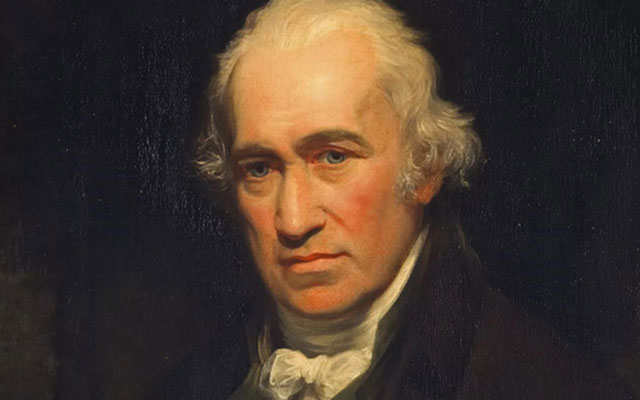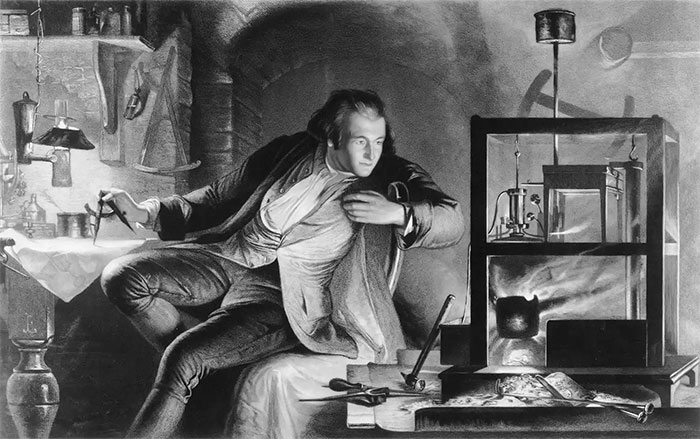January 19, 2019: A genius was born, laying the foundation for the Industrial Revolution that transformed humanity.
He was a Scottish inventor and engineer. With his important improvements to the steam engine, he became a key figure in the Industrial Revolution. He was also honored as the 22nd most influential man in history.
James Watt was born on January 19, 1736 in the coastal town of Greenock in Scotland. His father was a successful shipowner and shipbuilder. His mother came from a noble family. James Watt's grandfather was a mathematician and a local school principal. Therefore, young James was taught very carefully from a young age.
Although gifted in mathematics from a young age, James Watt could not go to school because of poor health. Instead, Watt stayed home and learned skills related to mechanical engineering.

James Watt (1736-1819).
Little Watt was an avid reader and always found something interesting in every book. By age 6, Watt was solving geometry problems and using his mother's teapot to learn about steam.
In his teens, James Watt began to show his abilities, especially in mathematics. In his spare time, Watt sketched in pencil, carved, and worked on wooden and metal tool benches. Watt created many ingenious mechanical models and enjoyed helping his father repair equipment.
At the age of 17, James Watt's mother passed away and his father's business was no longer developing as before. Watt spent a year in London researching the production of mathematical instruments before returning to Scotland to set up business in Glasgow. But because Watt did not undergo a seven-year apprenticeship, his plans were hindered. Instead, a professor at the University of Glasgow arranged for Watt to open a workshop on campus.

Young James Watt. (Photo: Getty Images).
James Watt began experimenting with steam in the early 1760s . Glasgow University then had a Newcomen-style steam model that did not work. Watt worked on the model engine in 1963 and tried to get it running again.
During this process, Watt discovered the problem of steam condensing in the same cylinder. He calculated that 80% of the energy in steam is wasted heating the cylinder during each cycle. His innovation was to condense the steam in a separate tank, to allow the cylinder to stay hot during operation.

Steam engine improved by James Watt. (Photo: Getty Images).
By 1765, his improvements were completed and had proven to be effective, providing significant efficiency over the simple Newcomen engine. But it took another decade for the first full engine to be born.
On his way to London to apply for a patent in 1768, Watt met Matthew Boulton, owner of a Birmingham manufacturing company called the Soho Manufactory of small metal articles.
Matthew Boulton is a man with both facilities and extensive knowledge of languages and sciences. Therefore, Watt began to cooperate with Boulton to produce his engines.
Over the following decades, the Boulton & Watt company made a series of important improvements to their steam engines. By the mid-1780s, their engines were five times more efficient than Newcomen's. The steam engines that Watt built became more and more advanced and supplied a large number to the market.
In 1782, the bidirectional steam engine researched and manufactured by Watt was officially born and patented. In 1784, the lying-down steam engine was also patented. Steam engines are increasingly practical and widely used and are called 'universal steam engines'.
By 1790, after improving and adding many parts, Watt completed the entire process of building his steam engine. And this is a giant leap in human production techniques, a milestone for the 'steam age'.
From that point forward, Boulton & Watt's company was able to produce a variety of motors that worked in real-world applications. New innovations and patents were applied to machines that could be used for grinding, weaving and milling. Steam engines were also used for road and water transportation. Nearly every important and successful invention that has marked the history of steam power over the years has originated in the workshops of Boulton & Watt.

James Watt's workshop was at Heathfield, where he lived from 1790 until his death. (Photo: Getty Images)
Watt retired from steam engine manufacturing in 1800, but continued to work on inventions in a number of fields. Looking at life today, we can see the enormous impact of the Industrial Revolution . Therefore, James Watt is also honored as one of the influential figures in human history and has been awarded many prestigious titles.
In 1819, Watt passed away at the age of 85. Watt's inventions fueled the Industrial Revolution and the innovations of modern times, from automobiles, trains and steamships to factories, not to mention the social problems that arose from them . Today, Watt's name is associated with units of measurement, with streets, museums and schools. His story has inspired books, films and works of art.
- What is Industry 4.0 Revolution?
- Inventing the origin of industrial revolution
- Top 5 inventions from the 18th century that changed the face of humanity
- 10 interesting things about 2 great scientists of humanity
- 10 rivers are forced to go to the ground
- Genius must ... have disabilities?
- Video: The reason some snakes give birth instead of laying eggs
- Technology contributes to promoting light revolution
- From the book boy becomes the genius scientist of humanity
- History of genius concept
- Auction for the final hand signature of the physical prince Stephen Hawking
- Beethoven genius musician
 The Indian prophet prodigy warned 3 events and what will happen on April 13, 2022
The Indian prophet prodigy warned 3 events and what will happen on April 13, 2022 Top 8 youngest professors in the world: Teaching university at the age of 18
Top 8 youngest professors in the world: Teaching university at the age of 18 Elena Cornaro Piscopia - The world's first female doctor of philosophy
Elena Cornaro Piscopia - The world's first female doctor of philosophy The ancient Greek philosopher was executed for understanding the Moon
The ancient Greek philosopher was executed for understanding the Moon